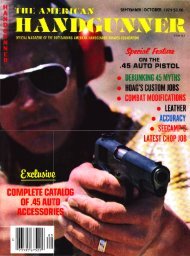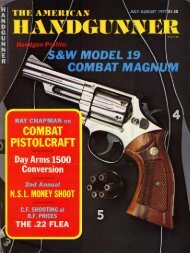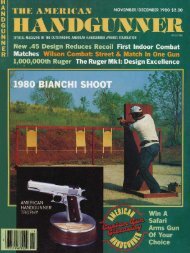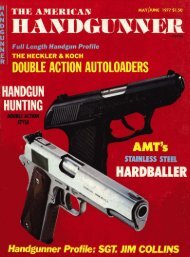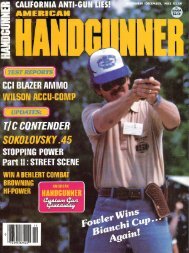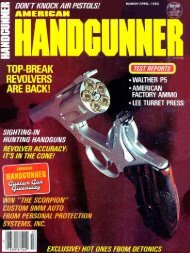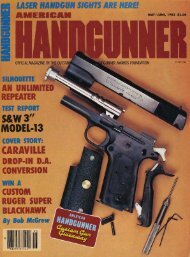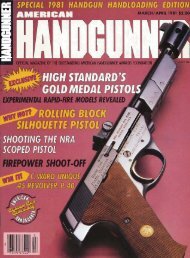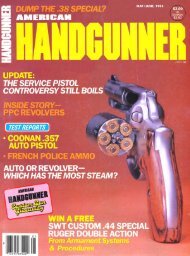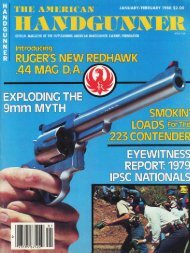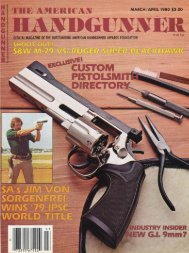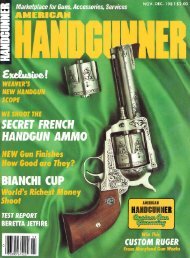American Handgunner May/June 1978
American Handgunner May/June 1978
American Handgunner May/June 1978
You also want an ePaper? Increase the reach of your titles
YUMPU automatically turns print PDFs into web optimized ePapers that Google loves.
My approach to curing end shake isn'treally a new idea, it's just an updated one.I knew guys ten years ago that would put apiece of shim stock inside the cylinder betweenthe end of the yoke and the front ofthe cylinder to set the end shake back. Imade a die to stamp my washers out ofround feeler gauge stock, two thousandthsand four thousandths of an inch thick. I'llput a .004" piece in to start when I'mworking on a Smith with end-shake, andreassemble the cylinder until the ejectorrod is good and tight, sometimes using atorque wrench that lets me know just howmuch pressure I'm using so I can getmaximum tightness without stripping thethreads or breaking the rod.I use a yoke alignment tool, a spud thatI'll drop in through the frame and see if itgoes right into the opening in the framethat's created when you hold back on thecylinder latch, when I reassemble it withthe yoke but without the cylinder. I want itto be rubbing on the left side a little bit,which shows me that when the action is inmotion and the cylinder is turning, therewill be a little tension helping to hold theyoke closed in proper alignment.From there it's a matter of reassemblingand trying the gun out, againand again; sometimes I'll have to add another.002" washer. The thing to rememberis, once you get it adjusted right, don'tdisassemble the cylinder group, or thosewashers may not get back in right, especiallyafter they've been seated with a fewhundred rounds of test firing.End-shake, if it isn't taken care ofproperly, can lead you to ruin your owngun. End shake can let the cylinder moveforward to where the front of the cylinderis rubbing on the rear of the barrel, and alot of people who really don't understandthe mechanism will try to cure it by filingdown the back end of the barrel, and thatjust ruins the revolver. If you've done thisto your own gun, about all you can do tofix it is take the barrel out, set it back onecomplete turn, and start all over.POWER ONCHAMFERING CHAMBERSChamfering the edges of the chambermouths is a good idea for any seriousshooting because if allows you to reloadmore smoothly and quickly, especiallywith speedloaders. I use a 40' angle, that Iput on with a special reamer that has astop on it, but a careful man who knowswhat he's doing can perform this with aDremel Moto-Tool. You can't go anydeeper and stay safe and functional, becauseif a guy is going to put a heavy handloadthrough there, you want to make surethat the brass case is supported by solidsteel all the way around. The safest'measurementon a Model 10 is a chamfer 40thousandths deep and sixty thousandthswide.POWER ON S&W MAINSPRINGSI don't like to alter the mainspring con-In the Ransom Rest is a PPC gun built on M-19 frame; left is aDouglas barreled .45 ACP on M-25; right is PPC gun on M-13.figuration. What I will do is polish it, notshave it down or anything, but polish it toremove the toolmarks. This prevents thespring fracturing at some future time dueto heavy-use fatigue, since if it were goingto break, the toolmarks would be a startingpoint for the fracture. But you have tobe sure not to polish to the extent of thinningthe spring or of changing the dimensionsto any significant degree.POWER ON SELECTINGA CUSTOM BARRELI stay with the Douglas Premium barrel,for the quality and consistency. Now,Douglas won't furnish these barrelsthreaded; that's something the pistolsmithhas to do for himself. One mistake that alot of beginners make is to put the barrelon backwards. The bore is cut from oneend, and you have to go with the grain ofthe metal; which end of the blank youthread to the gun makes a very real difference.Douglas Premium barrels aremarked with an "XX" and that is alwayson the rear end of the barrel. There's alsoa slightly larger diameter step on the rearend.You've got to get that end in place, sothat the bullet is travelling in the same directionin which the bore was "ironedout." Going "against the grain," you'll no-AMERICAN HANDGUNNER * MAY/JUNE <strong>1978</strong>



